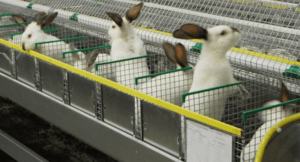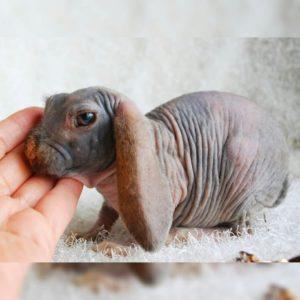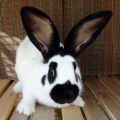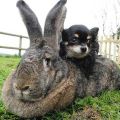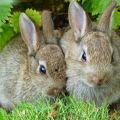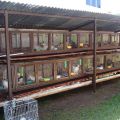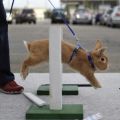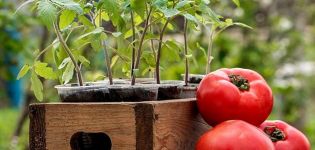Description and characteristics of rabbits of the Flanders breed, home care
Flandra rabbits are the oldest breed of mammals, the order of Lagomorphs, distinguished by their solid size and increased fertility. The people call these eared giants, giant rabbits. But rabbit breeders appreciate them not only for their great weight - the unpretentiousness and physical endurance of rabbits make them the favorites of farmers. However, extreme heat and severe frosts are destructive for these animals.
Content
The history of the breed
For the first time, the world heard about the Flandre rabbit breed in 1860, when the first individuals appeared in the Belgian province of Flanders. There is no exact information about the date of creation of the breed. Versions of the origin of the genus Flanders:
- Rabbits are descendants of Patagonian relatives brought from Argentina in the 16th and 17th centuries.
- Belgian giants are descendants of Flemish rabbits. This species stopped breeding and eventually disappeared completely.
- Flanders are the result of crossing rabbits from Patagonia, Argentina, Flemish.
All over the world, their own breeds of Belgian Flanders have been created. They have slight differences from their tribal relatives, as they are adapted to their regions. This is how the subspecies German, Spanish, English appeared, and the gray and white giants have been allowed for breeding in the Russian Federation since 1993.
Description and characteristics of thoroughbred flanders
Nature has endowed rabbits of the Flanders breed with a long body, a dark muzzle with brown eyes, chubby cheeks and erect ears. The giants have massive paws, they beat the opponent with them, defend themselves. The coat is short (3.5-4 cm), thick, darker on the barrels and back than on the belly. The body color ranges from almost black to sandy brown and gray, and the nails are identical in color to the coat.
The mass of adult flanders rabbits is about 11-12 kg, sometimes up to 25 kg. The length of the body is about 80 cm, the chest girth is 36-38 cm. The weight of a rabbit at 2 months is about 2 kg, but already an 8-month-old baby weighs 7-8 kg. The average life span of flanders rabbits is 5 years, but with proper care it increases. Rabbits quickly get used to a person and are able to live with him in the same territory.
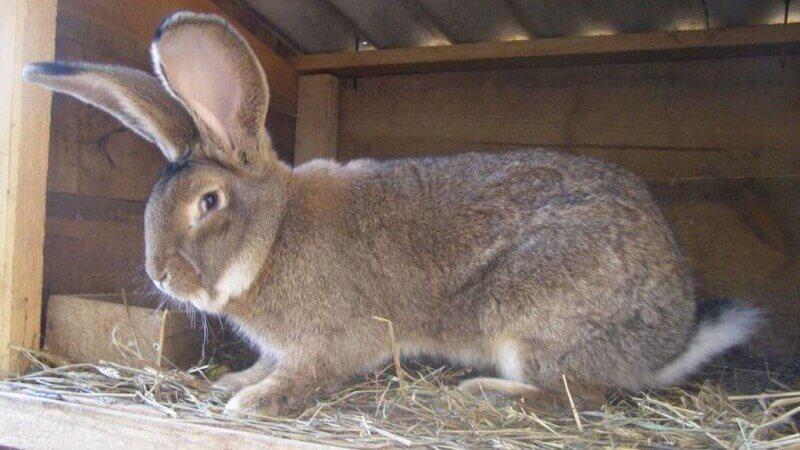
Temperament
Rabbits of the Flanders breed have excellent intelligence, quickly get used to their nicknames. The character is peaceful, playful. They like to communicate with children, are not aggressive towards adults.
Quality of the breed
The differences between the Belgian giant rabbits and their relatives are not only a muscular body. They are distinguished by other features:
- long erect ears (23-25 cm);
- short fur;
- an even and only sometimes slightly concave back;
- a wide range of colors inherent in various types of rabbits;
- the color of the claws, identical to the color of the fur coat;
- proportional to the body with four legs.
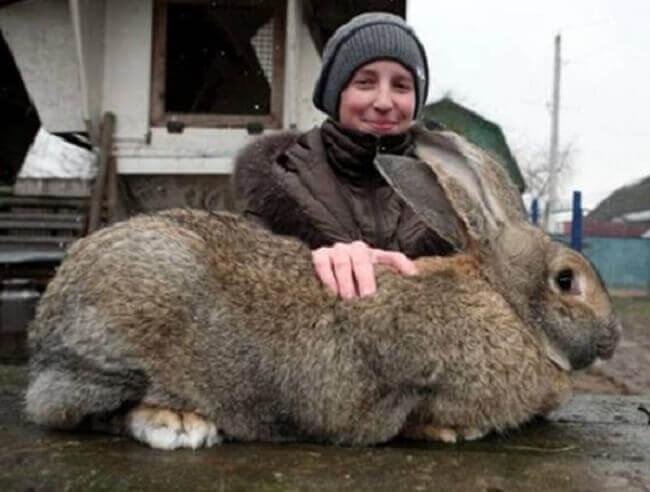
But the main difference between the representatives of the breed is a kind of fold on the chin.
Productivity
By 8 months, the female giant rabbit is considered sexually mature. One litter gives birth to 6-8 babies, a large individual - up to 15 cubs. Milk-eared eared are high, mothers are feeding numerous offspring. Rabbits are rapidly gaining weight, monthly babies weigh about 1 kg. The volume of meat in rabbits of the Flanders breed is low - about 55%. From one Belgian rabbit weighing 5.5 kg, you can take about 3 kg of meat.
Pros and cons
The Belgian giant rabbit breed has its pros and cons. Advantages:
- high fertility, milk production of rabbits;
- resistance to disease and temperature changes;
- unpretentiousness in feeding;
- physical endurance of rabbits;
- growing in the house, like a pet;
- friendly, playful temperament;
- cultivation for obtaining skins, meat.

Cons of flanders rabbits:
- Voracity. Rabbits eat incessantly, so they require a lot of food. That is why flanders grow quickly and gain weight.
- Poor quality of skins. Despite the high density of the coat, down, which is valued much higher, is almost absent. Moreover, the wool grows unevenly, its length is different throughout the body.
- Congenital anomalies. Often, giants have deformation and underdevelopment of the limbs.
- Bloating. Young rabbits are prone to digestive tract disorders, the salvation is the addition of drugs to food.
- Long-term adaptation. When flanders rabbits move from one region to another, they often catch a cold. In particular, this concerns the transportation of animals from Europe or warm regions of Russia to cold strips.
- Long ripening. Rabbits of meat breeds ripen 2 times faster than flanders and become suitable for slaughter for meat.
Scientific breeders are constantly working on improving the qualities of this breed, and the work is gradually pleasing with a positive result.
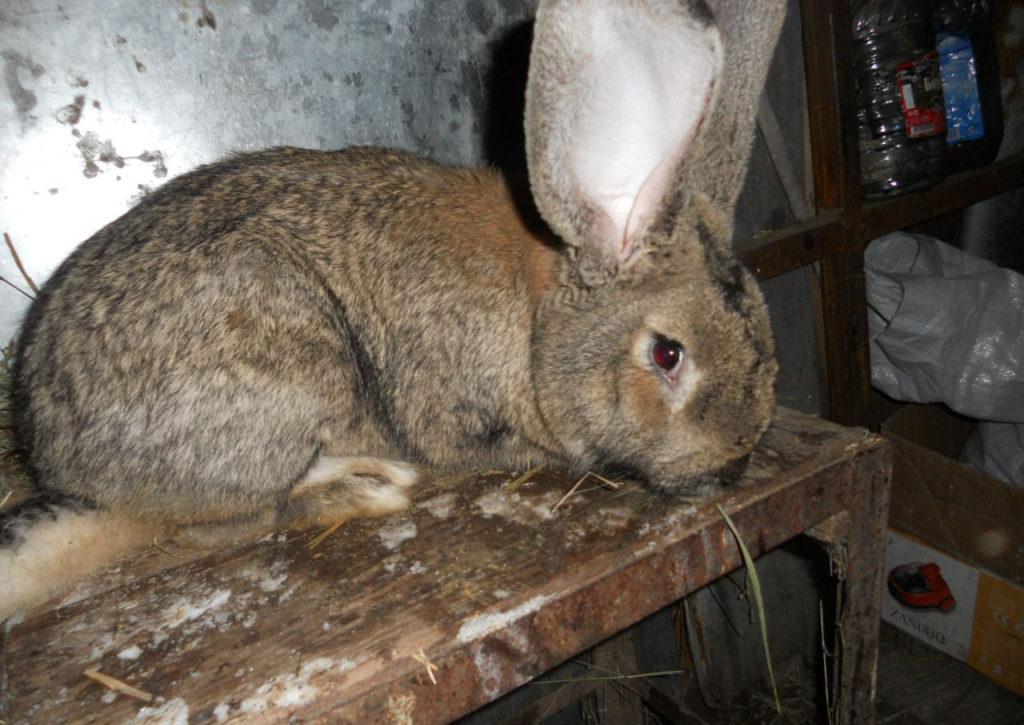
Recommendations for maintenance and care
Experienced rabbit breeders claim that it is difficult to properly care for the Belgian giants. Animals are demanding for warmth, constant availability of food and the size of the cages. Especially large living space is needed for females with rabbits. Despite the resistance to respiratory diseases, it is important to keep rabbits in cages that are constantly being disinfected. The houses are regularly cleaned and ventilated and the bowls are filled with fresh water.
It is advisable to build cells from natural materials. The walls are constructed from boards, a sheet of plywood, and the frame and supporting elements are made of wooden beams. The flooring is made of slats or mesh, the roof is also covered with plywood or boards. When building cages, the size of animals, the number of individuals on one living space and their weight are taken into account. For a female with rabbits, a cage with dimensions of 170x110x50 cm is suitable, for a lone rabbit - 110x70x50 cm.
It is recommended to place the cages at least 1 m above the ground, otherwise the flanders will be harmed by rats or ferrets. In addition, cleaning such a house is more convenient. With the onset of spring, until mosquitoes-carriers of diseases appeared, giant rabbits are vaccinated against myxomatosis, hemorrhagic viral fever and pasteurellosis. The first vaccination is given at 1.5 months. When they reach 8 months, the rabbits are suitable for breeding. Flanders can be raised at home - they are good-natured to children and adults.
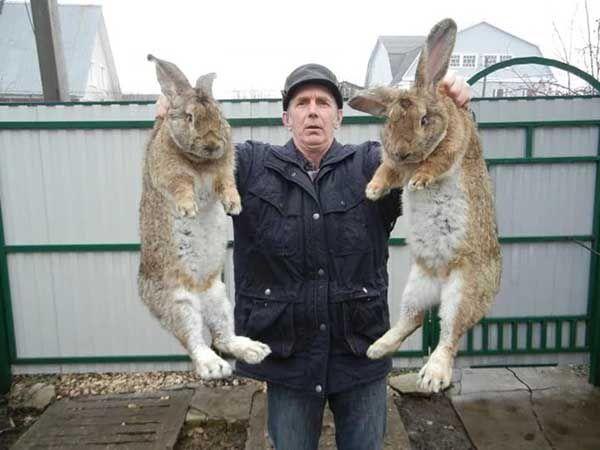
What to feed
Biomycin is added to the food of giant rabbits. He saves flanders, especially at a young age, from bloating and death. The food of eared pets consists of dry hay, which is given to them daily. Also, animals are not averse to taste wet mixtures, grain foods. The diet should contain mixed feed and finely chopped vegetables:
- carrot;
- boiled potatoes;
- fodder beets;
- white cabbage;
- pumpkin.
Food is sometimes slightly salted, diluted with meat and bone meal, and, if necessary, supplied with medicines. A prerequisite is the presence of fresh, clean water in the bowl. The rabbits are fed at the same time. Freshly picked grass is first dried and only then offered to the rabbit. It is forbidden to include in food:
- potato tops;
- twigs of broom, elderberry;
- hellebore;
- lilies of the valley;
- St. John's wort;
- cornflowers;
- poisonous celandine;
- bleached;
- nightshade.
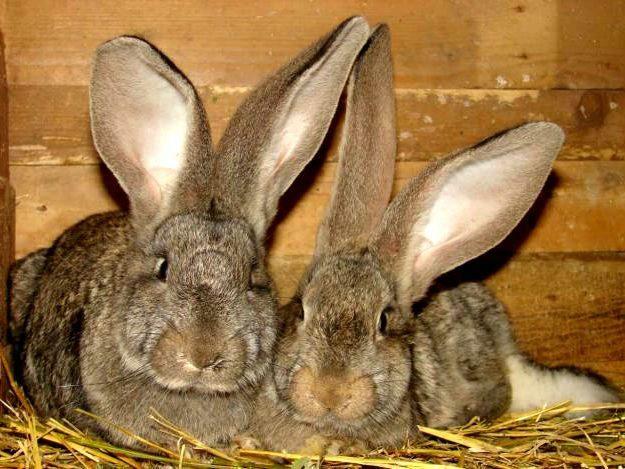
These plants are fatal for flanders.
Breeding rules
Breeding of Belgian giants-flanders does not cause problems for breeders: rabbits willingly mate, females give birth to rabbits without much difficulty. This happens when the rabbits are 8 months old, and the males are 4 months old. The female comes hunting once within 5-15 days. Her pregnancy lasts 28-30 days, 6-8 (sometimes up to 15) cubs are born in one litter.
Rabbits grow quickly with good care. Each month, each baby gains about 1-1.5 kg of weight. In the first couple of months, the rabbits feed on their mother's milk, she cleans them and warms them. Having reached the age of 21 days, the offspring try "adult" food.
As soon as the pups of the Flanders breed completely switch to it, biomycin is added to their diet, they monitor the presence of water in the bowls.
The cages are placed away from drafts and direct sun, since the Belgian rabbits die from heatstroke. Pressed granules are poured into the houses as a filler, which is changed daily. When keeping a giant in an apartment, the floors are covered with carpeting, since laminate, linoleum and parquet flooring cause pododermatitis in rabbits.
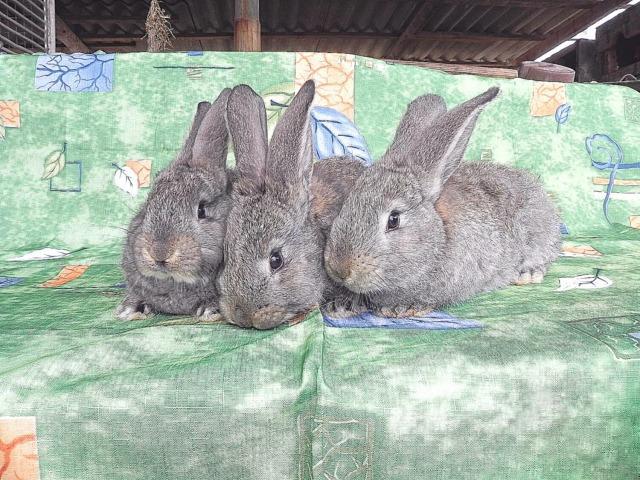
Possible diseases
Without vaccination, rabbits of the Flanders breed pick up hemorrhagic viral fever, pasteurellosis, myxomatosis from mosquitoes. Also, when moving from a warm region to a cold region, giants can catch a cold. For rabbits, heat and strong drafts are destructive, they are susceptible to tick attacks.
Tips for choosing a rabbit of this breed when buying
It is recommended to purchase Belgian flanders rabbits in farmsteads where experienced rabbit breeders are engaged in breeding breeds. It is desirable that the rabbit was born from a 2-3-year-old rabbit and fed on her milk for at least 2 months.
When choosing flanders rabbits, pay attention to:
- cleanliness of fur, grooming;
- the presence of a large number of cubs in the litter;
- the age of the rabbit;
- lack of darkening and sticking on the paws.
Purebred Flandra rabbits stand out:
- body length (about 90 cm);
- chubby cheeks;
- erect ears 18-25 cm long and a black border on the upper edge;
- wide chest with a large depression;
- weight (at the age of 8 months, body weight 6-8 kg);
- chin fold.
The coat color of purebred flanders rabbits is varied, therefore this aspect is not taken into account.
